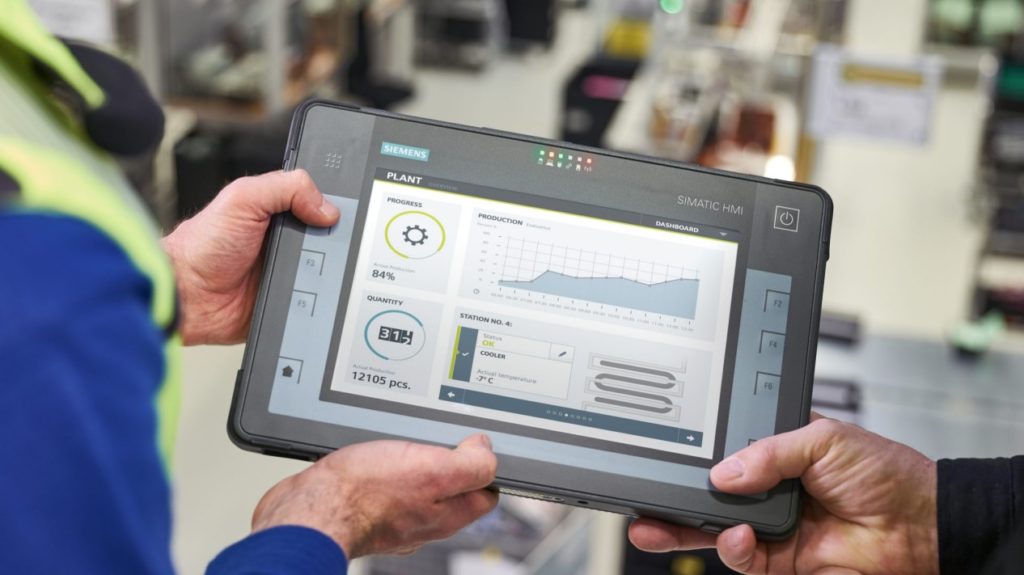Tablet PC: Maximum mobile performance, every day
The robust SIMATIC ITP1000 Tablet PC gives you flexibility: Thanks to its long battery life, the tablet is suitable for all-day mobile use in the entire industrial environment.

The robust SIMATIC ITP1000 Tablet PC gives you flexibility: Thanks to its long battery life, the tablet is suitable for all-day mobile use in the entire industrial environment.

SIMATIC WinCC Open Architecture is part of the SIMATIC HMI family and designed for applications of large scale and high complexity as well as projects with special requirements on system perequisites and customized functionality.

SIMATIC WinCC Open Architecture is a SCADA system for visualizing and operating of processes, production flows, machines and plants in all lines of business. Distributed systems enable any number of stand-alone systems, from 2 to 2048, to be linked via a network.
Each subsystem can be configured either as a single-user or multi-user system, redundant or not, in each case. SIMATIC WinCC Open Architecture relies consistently on object orientation for process images and the database structure.

The SIMATIC ODK 1500S supports the development of Windows and real-time library functions for the SIMATIC S7-1500 Software Controller and enables the integration of Code C++ higher-level languages.
The SIMATIC ODK 1500S combines PLC programming with programming in complex higher-level languages, such as C++, in the simplest possible way.
Windows library applications
Real-time library applications
Generation of loadable libraries
Generation of loadable function libraries takes place with Microsoft Visual C++ for Windows library applications and with Eclipse for real-time function libraries. By creating a project with the help of a pre-defined template, users can begin immediately with the definition and implementation of their functions.
On completion of a function library, function blocks are available that can be integrated directly into STEP 7 and used for loading and executing the functions from the control program.
The function libraries themselves are available following completion as DLL (Windows libraries) or SO file (Shared Object – real-time libraries). Real-time libraries are loaded into the load memory of the Software Controller by its Web server so that they can also be loaded and executed independently of Windows.
For Windows libraries, the complete function range can be used for Windows DLLs. Development is carried out with Visual Studio; the following versions are supported:
Windows libraries can be fully debugged with Visual Studio. Thanks to the asynchronous execution of functions under Windows, the real-time characteristics of the Software Controller are not impaired even if single-step processing or breakpoints are used.
A powerful trace concept is available for real-time libraries as single-step processing or breakpoints are not feasible under real-time conditions. To verify the code with single-step processing or breakpoints despite this, the functions of a real-time library can be called up and tested within a test environment on the development PC.
Licensing

Via interface modules the ET 200 pro is connected to the bus system, either the proven fieldbus PROFIBUS or PROFINET the leading Industrial Ethernet Standard.
ET 200pro Interface Modules are offered with CPU functionality in standard or failsafe variants.
The ET 200pro distributed I/O system is being expanded with CPU 1516pro-2 PN and CPU 1516pro F-2 PN. The new CPUs are based on the S7-1500 CPU 1516-3 PN/DP and offer two PROFINET IO communication interfaces.
The CPUs 1516pro-2 PN Standard and Fail-safe have a PROFINET IO interface with three PROFINET ports. The three ports have the same properties. In addition, you can implement a ring redundancy (MRP or MRPD) with ports 1 and 2. Ports 1 and 2 with M12 cable gland, as known from the IM154-8 PN/DP CPUs, are connected to the CPU by means of a connection module. Port 3 is a RJ45 socket that is permanently integrated into the CPU enclosure behind a porthole.
The 1516pro-2 PN and 1516pro F-2 PN CPUs support PROFINET IRT through this PN interface and thus permit short, predictable response times, even faster, deterministic data exchange with IO devices and a high immunity to interference from non-real-time data communication.